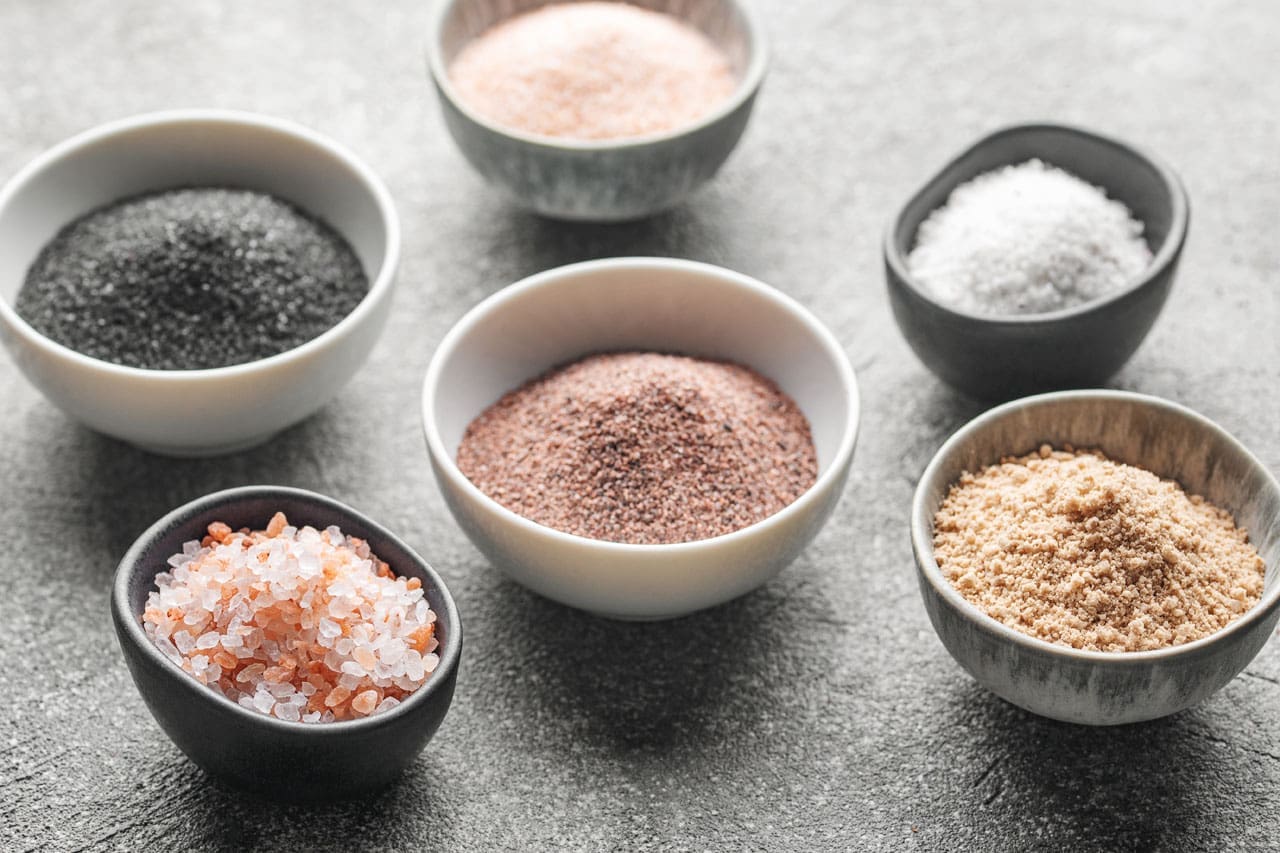
“For individuals looking to improve their diet, can knowing the different salt types help in food preparation and health?”

Table of Contents
Salt Types
Salt brings out the natural flavor of foods and can be used as a preservative. Salt types come in various colors and textures for cooking, flavor, and health. Some are considered healthier compared to regular table salt, like pink Himalayan salt and different sea salts. Some individuals prefer them because most go through less processing and can have more trace minerals like magnesium and potassium. However, all salts are healthy in moderation, as sodium is a necessary part of a balanced diet. Although essential for the body, sodium can be harmful when too much is consumed. A study examining consumer-grade pink Himalayan sea salts available in Australia determined that to receive the additional health benefits of the minerals from this type of salt, individuals must consume so much that it elevates the amount of sodium in the body to dangerous levels. (Flavia Fayet-Moore et al., 2020)
Salt
Salt is a mineral made from the combined elements:
- Sodium – Na
- Chlorine -Cl
- Together, they form crystallized sodium chloride NaCl.
The majority of salt production comes from evaporated seawater and salt mines. Many salts used in food preparation are iodized. Iodine is added to various refined salt products to help meet nutritional requirements. Iodine intake levels that fall below the recommended values could result in a deficiency and develop goiter. Goiter is associated with hypothyroidism. (Angela M. Leung et al., 2021) Lack of iodine can also have adverse effects on growth and development. (National Institutes of Health Office of Dietary Supplements. 2023)
Essential for Health
Salt sustains life and optimal bodily function. Sodium and chlorine are important elements that maintain:
- Cellular balance
- Circulation
- Blood sugar levels
Sodium is a mineral and an electrolyte. Common electrolytes include potassium, calcium, and bicarbonate. Without adequate sodium levels, the brain cannot send the necessary impulses to the rest of the body to function properly. However, consuming too much salt can cause health issues.
- Higher salt intake in individuals who are sensitive to salt can increase blood pressure.
- Doctors usually recommend that individuals with hypertension reduce sodium intake or follow a low-sodium diet.
- Elevated sodium levels also cause water retention – considered a protective response as the body works to regulate serum sodium levels concentration in the blood to maintain balance.
- If levels are too high, a condition known as hypernatremia can develop, which can cause:
- Excessive thirst
- Vomiting
- Infrequent urination
- Diarrhea
- Sodium levels that are too low can lead to hyponatremia, which can cause:
- Fatigue
- Weakness
- Confusion
A blood test will determine whether serum sodium concentration is high, low, or normal. (U.S. National Library of Medicine. MedlinePlus. 2022)
- One teaspoon of salt contains around 2,360mg of sodium. (U.S. Department of Agriculture. FoodData Central. 2020)
- Though there are different types of salt, they all contain roughly the same amount of sodium.
Types
The average sodium intake by adults is around 3,393mg per day, ranging between 2,000–5,000mg. Guidelines recommend a maximum intake of 2,300mg per day. (U.S. Department of Health and Human Services and U.S. Department of Agriculture. 2020) Whether from unhealthy dietary choices like processed foods or incorrect knowledge of sodium content when cooking, an American Heart Association survey showed that more than half of respondents inaccurately stated that sea salt had a lower sodium content than table salt. (American Heart Association. 2024)
Refined – Table Salt
Refined/iodized salt is finely granulated and commonly used in cooking. This type is highly refined to remove impurities and eliminate trace minerals often found in specialty salts. Because the salt is finely ground, anti-caking agents are added to ensure the salt doesn’t clump. Some table salts also have added sugar and other additives.
- Refined table salt is about 97–99% sodium chloride (NaCl).
- Iodine is added to prevent iodine deficiency.
- Individuals trying to reduce sodium intake but meet iodine levels can do so with foods like eggs, dairy products, and fish.
Kosher
Kosher salt is coarse and flakey and can add a crunchy texture to dishes and drinks. Pure kosher salt does not contain additives like anti-caking agents and iodine. The size of the salt crystals is ideal for drawing out moisture.
- Per teaspoon, kosher salt generally has less sodium than 1 teaspoon of table salt.
- Because it has a coarser grain, less salt fits in the measuring spoon.
Sea Salt
Sea salt is produced from evaporated seawater and comes as fine grains or large crystals. Examples include:
- Black Sea
- Celtic
- French – fleur de sel
- Hawaiian sea salt
Sea salt can have trace amounts of minerals like iron, potassium, and zinc, which can produce different flavors in cooking but no additional health benefits with normal consumption. Some sea salts may also contain trace amounts of microplastics. However, research indicates these amounts are too low to warrant public health concerns. (Ali Karami et al., 2017)
Himalayan Pink Salt
Himalayan pink salt is mined in the red salt range in Pakistan, the second-largest salt mine in the world, and in the Andes mountains of Peru. Trace amounts of iron oxide make the salt pink. It is typically used at the end of cooking to add flavor and a crunch. Himalayan salt is popular for its health benefits and mineral properties. However, using Himalayan salt over other types has no known health advantages. Researchers concluded that the potential health benefits provided by the higher nutrient content would be counteracted by the large amount of sodium that would need to be consumed. (Flavia Fayet-Moore et al., 2020)
Substitutes
Salt substitutes contain some or all sodium and potassium, magnesium, or other minerals. Substitutes can be half sodium chloride and half potassium chloride. Monosodium glutamate/MSG can also be used as an alternative. A study found that substituting salt with MSG is safe and comparable to salt flavor. (Jeremia Halim et al., 2020) Individuals often use substitutes on a sodium-restricted diet but should check with their doctor before using these products, especially if they have kidney conditions.
Body In Balance – Chiropractic+Fitness+Nutrition
References
Fayet-Moore, F., Wibisono, C., Carr, P., Duve, E., Petocz, P., Lancaster, G., McMillan, J., Marshall, S., & Blumfield, M. (2020). An Analysis of the Mineral Composition of Pink Salt Available in Australia. Foods (Basel, Switzerland), 9(10), 1490. doi.org/10.3390/foods9101490
Leung, A. M., Braverman, L. E., & Pearce, E. N. (2012). History of U.S. iodine fortification and supplementation. Nutrients, 4(11), 1740–1746. doi.org/10.3390/nu4111740
National Institutes of Health Office of Dietary Supplements. (2023). Iodine: Fact Sheet for Professionals. Retrieved from ods.od.nih.gov/factsheets/Iodine-HealthProfessional/
U.S. National Library of Medicine. MedlinePlus. (2022). Sodium blood test. Retrieved from medlineplus.gov/lab-tests/sodium-blood-test/
U.S. Department of Agriculture. FoodData Central. (2020). Salt. Retrieved from fdc.nal.usda.gov/fdc-app.html#/food-details/1112305/nutrients
U.S. Department of Health and Human Services and U.S. Department of Agriculture. (2020). 2020–2025 Dietary Guidelines for Americans. Retrieved from www.dietaryguidelines.gov/sites/default/files/2020-12/Dietary_Guidelines_for_Americans_2020-2025.pdf
American Heart Association. (2024). Sea Salt vs. Table Salt (Healthy Living, Issue. www.heart.org/en/healthy-living/healthy-eating/eat-smart/sodium/sea-salt-vs-table-salt
Karami, A., Golieskardi, A., Keong Choo, C., Larat, V., Galloway, T. S., & Salamatinia, B. (2017). The presence of microplastics in commercial salts from different countries. Scientific reports, 7, 46173. doi.org/10.1038/srep46173
Halim, J., Bouzari, A., Felder, D., & Guinard, J. X. (2020). The Salt Flip: Sensory mitigation of salt (and sodium) reduction with monosodium glutamate (MSG) in “Better-for-You” foods. Journal of food science, 85(9), 2902–2914. doi.org/10.1111/1750-3841.15354
Disclaimers
Professional Scope of Practice *
The information herein on "Discover the Different Salt Types for Health & Flavor" is not intended to replace a one-on-one relationship with a qualified health care professional or licensed physician and is not medical advice. We encourage you to make healthcare decisions based on your research and partnership with a qualified healthcare professional.
Blog Information & Scope Discussions
Welcome to El Paso's wellness blog, where Dr. Alex Jimenez, DC, FNP-C, a board-certified Family Practice Nurse Practitioner (FNP-C) and Chiropractor (DC), presents insights on how our team is dedicated to holistic healing and personalized care. Our practice aligns with evidence-based treatment protocols inspired by integrative medicine principles, similar to those found on dralexjimenez.com, focusing on restoring health naturally for patients of all ages.
Our areas of chiropractic practice include Wellness & Nutrition, Chronic Pain, Personal Injury, Auto Accident Care, Work Injuries, Back Injury, Low Back Pain, Neck Pain, Migraine Headaches, Sports Injuries, Severe Sciatica, Scoliosis, Complex Herniated Discs, Fibromyalgia, Chronic Pain, Complex Injuries, Stress Management, Functional Medicine Treatments, and in-scope care protocols.
Our information scope is limited to chiropractic, musculoskeletal, physical medicine, wellness, contributing etiological viscerosomatic disturbances within clinical presentations, associated somato-visceral reflex clinical dynamics, subluxation complexes, sensitive health issues, and functional medicine articles, topics, and discussions.
We provide and present clinical collaboration with specialists from various disciplines. Each specialist is governed by their professional scope of practice and their jurisdiction of licensure. We use functional health & wellness protocols to treat and support care for the injuries or disorders of the musculoskeletal system.
Our videos, posts, topics, subjects, and insights cover clinical matters, issues, and topics that relate to and directly or indirectly support our clinical scope of practice.*
Our office has reasonably attempted to provide supportive citations and has identified the relevant research studies or studies supporting our posts. We provide copies of supporting research studies available to regulatory boards and the public upon request.
We understand that we cover matters that require an additional explanation of how they may assist in a particular care plan or treatment protocol; therefore, to discuss the subject matter above further, please feel free to ask Dr. Alex Jimenez, DC, APRN, FNP-BC, or contact us at 915-850-0900.
We are here to help you and your family.
Blessings
Dr. Alex Jimenez DC, MSACP, APRN, FNP-BC*, CCST, IFMCP, CFMP, ATN
email: coach@elpasofunctionalmedicine.com
Licensed as a Doctor of Chiropractic (DC) in Texas & New Mexico*
Texas DC License # TX5807
New Mexico DC License # NM-DC2182
Licensed as a Registered Nurse (RN*) in Texas & Multistate
Texas RN License # 1191402
ANCC FNP-BC: Board Certified Nurse Practitioner*
Compact Status: Multi-State License: Authorized to Practice in 40 States*
Graduate with Honors: ICHS: MSN-FNP (Family Nurse Practitioner Program)
Degree Granted. Master's in Family Practice MSN Diploma (Cum Laude)
Dr. Alex Jimenez, DC, APRN, FNP-BC*, CFMP, IFMCP, ATN, CCST
My Digital Business Card






